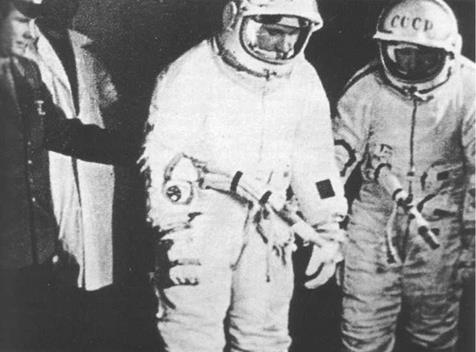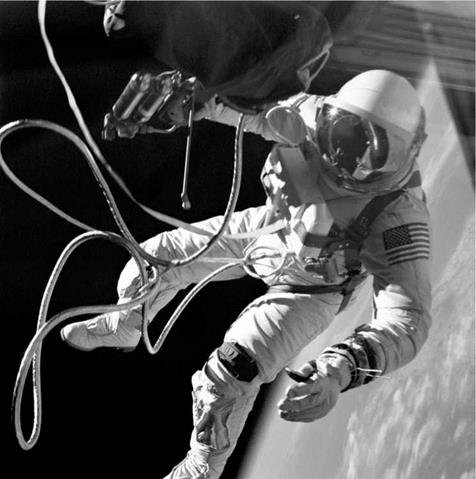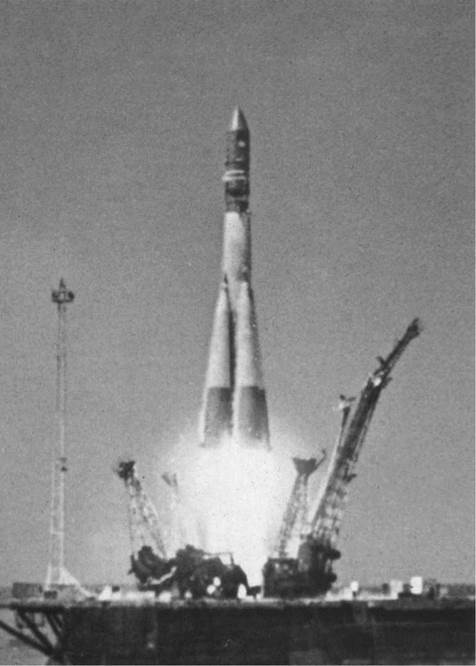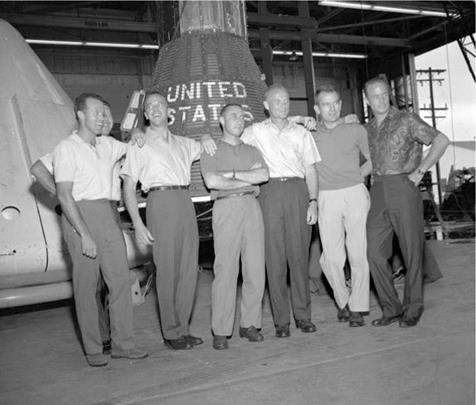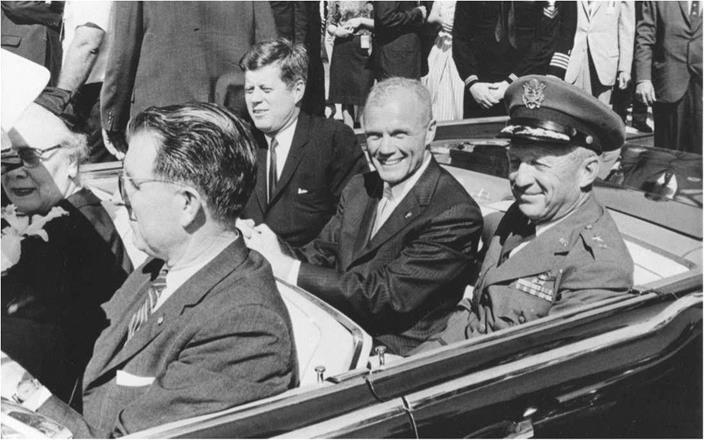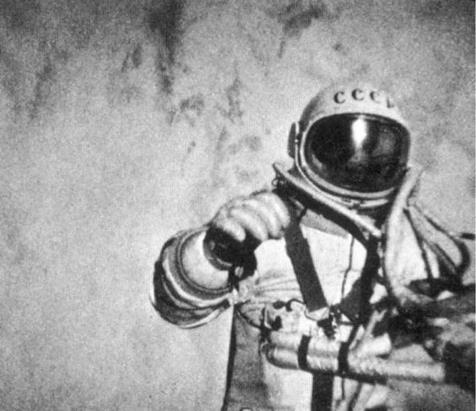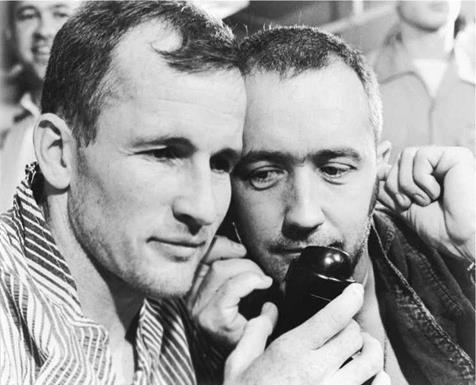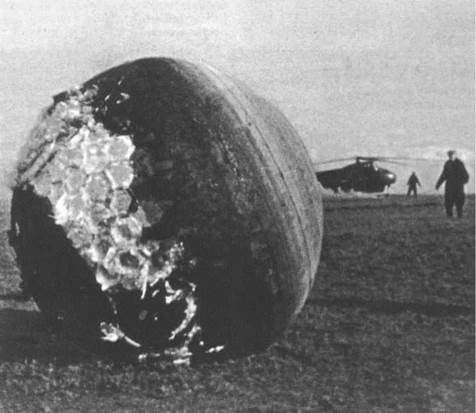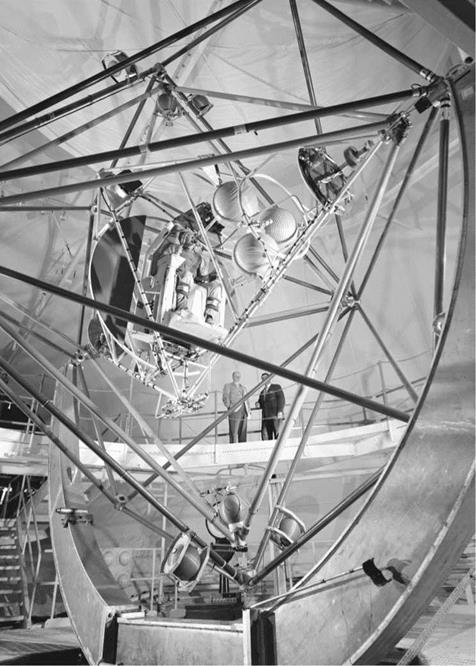“LEAVE THE RETRO PACKAGE ON”
Meanwhile, Glenn continued putting his capsule through its paces, evaluating its abilities in manual, automatic and fly-by-wire modes. It was shortly after passing the two-hour mark of the mission, however, that he received an unusual request from Mission Control: to keep the switch for Friendship 7’s landing bag in the ‘off’ position. He confirmed that the switch was indeed off and pressed on with his work. Later, as he flew over Muchea, Gordo Cooper asked him to confirm it again. Then, during another pass over Canton Island, Glenn overheard an indication from a flight controller that his landing bag – located between the base of the spacecraft and the heat shield – might have accidentally deployed. He queried Mission Control and was assured that the ground was merely monitoring the situation. Glenn began to suspect that the fireflies could be related, perhaps, to some shifting of his heat shield and landing bag.
Already, as early as the second orbit, an engineer at the telemetry console named William Saunders, had noted that ‘Segment 51’ – an instrument providing data on the landing system – was generating unusual readings and Mercury Control instructed all tracking sites to monitor it carefully. A little over four hours into the flight, however, it became clear that the landing bag might be deployed or, at least, not securely locked into position. Whilst over Hawaii, the duty capcom informed Glenn that the signal was probably erroneous, but, to be sure, asked him to set the landing bag switch in its ‘auto’ position. ‘‘Now, for the first time, f knew why they had been asking about the landing bag,’’ Glenn wrote. ‘‘They did think it might have been activated, meaning that the heat shield was unlatched. Nothing was flapping around. The package of retrorockets that would slow the capsule for re-entry was strapped over the heat shield. But it would jettison and what then? ff the heat shield dropped out of place, f could be incinerated on re-entry.’’
ff the green landing bag light came on, Glenn wrote, it would clarify that it had indeed accidentally deployed. However, ‘‘if it hadn’t, and there was something wrong with the circuits, flipping the switch to automatic might create the disaster we had feared’’. He flipped the switch. No light. This suggested that the landing bag was secure. As retrofire approached, Capcom Wally Schirra, based at Point Arguello in California, told Glenn not to jettison his retrorocket package at least throughout his passage across Texas. ft marked the first of several efforts to ensure that, if the heat shield had been loosened, the retrorocket package might hold it in place just long enough to survive the hottest part of re-entry.
Glenn, meanwhile, had worries of his own. From the end of his first orbit, he had experienced problems with Friendship 7’s automatic control system, as the capsule started to swing over to one side along its yaw axis, corrected itself at considerable expense of hydrogen peroxide fuel, before doing the same again. ‘‘ft became necessary for me to control the capsule’s movements by hand,’’ he said later. ‘‘For most of the rest of the trip, f controlled the capsule myself. This did cut down on the other activities we’d planned. ft meant that f had to cancel several of the experiments and observations f wanted to make on the second and third orbits.’’ These would have included observations of the solar corona, terrestrial cloud structures, his ability to adapt his eyes to orbital darkness and further studies of the effects of weightlessness. ‘‘f was able to take far fewer pictures than f’d intended,’’ Glenn continued, ‘‘and f had to pass up my plan to have two meals during the flight to test my ability to get food down under various conditions.’’
Throughout most of his second orbit, as the ground pondered the Segment 51 situation, Glenn persevered with his efforts to determine the problem with the automatic control system. ‘‘f could hear the large fuel thrusters outside the capsule as they popped off their bursts of hydrogen peroxide in first one direction and then the other,’’ he said. ‘‘f could feel the slight throb of the smaller nozzles when f cut them in. The manual system had been a little mushy. ft did not respond quite as crisply as f thought it should have, but f still had good control. ft worked best when f switched to
the fly-by-wire mode, which combines the manual control stick and the fuel nozzles which are operated by the automatic system. This meant that f could work the automatic system by hand and conserve its fuel. Though this routine took most of my attention and kept me rather busy for the next three hours, f thoroughly enjoyed it. The idea that f was flying this thing myself and proving on our first orbital test that a man’s capabilities are needed in space was one of the high spots of the day. The value of this outweighed the loss of some of the things f did not get to do.’’ Coupled with the landing bag situation, however, these malfunctions contributed to shortening the mission from a possible seven orbits to the original three.
Six minutes before retrofire, Glenn duly manoeuvred Friendship 7 into a 14- degree, nose-up attitude. At 2:20 pm, the first retrorocket fired, causing a dramatic braking effect on the capsule and making him feel momentarily as if he was flying backwards, towards Hawaii. The second and third retrorocket firings came at five – second intervals, slowing the capsule sufficiently to drop it out of orbit. Once again, Schirra repeated: “Keep your retro pack on until you pass Texas’’. The tension at Mission Control was palpable. “f looked around the room,’’ wrote Gene Kranz, “and saw faces drained of blood. John Glenn’s life was in peril.’’
Throughout the early stages of re-entry, Glenn and Schirra chattered like a pair of tourists exchanging travel notes, as Friendship 7 came within sight of El Centro and the fmperial Valley, followed by southern California’s Salton Sea. Then, as he passed over Corpus Christi, Glenn was told again, with evident urgency, to “leave the retro package on through the entire re-entry’’. This meant that he would have to override the 0.05 G switch – which sensed atmospheric resistance and started the capsule’s reentry program – and manually retract the periscope. Glancing at the on-board clock, which had ticked off four hours, 38 minutes and 47 seconds since launch, his suspicions resurfaced that the reason for keeping the retro package on throughout re-entry was because the heat shield was loose.
He would later admit to irritation at being kept, officially, in the dark about the potential disaster looming ahead. fnformation about his spacecraft was his lifeblood, he wrote in his post-flight report, and it was knowledge, not absence of knowledge, which informed each of his decisions. Despite asking for Mission Control’s reasons for wanting the package kept in place, he was told only that the decision was “the judgement of Cape Flight’’. fn Florida, Al Shepard gave Glenn as much information as he had available. “We’re not sure whether or not your landing bag has deployed,’’ he said. “We feel it is possible to re-enter with the retro package on. We see no difficulty at this time with this type of re-entry.’’
Although the package and its three metal straps would eventually burn up as Friendship 7 plunged deeper into the atmosphere, Glenn assumed that, by keeping it on, the capsule might be protected for long enough until the thickening air could firmly hold the heat shield against Friendship 7’s base. Max Faget, the father of the Mercury spacecraft, agreed with the plan of using the retrorocket package to hold the heat shield in place, but admitted that it posed its own risks: any unused solid fuel could explode when re-entry temperatures grew too hot, destroying the capsule. Flight Director Chris Kraft chimed in with additional concern that the attached retrorocket package could cause Friendship 7 to tumble, incinerating both it and
Glenn. Kraft, although eventually persuaded by Faget and Walt Williams, strongly felt that the ‘cure’ could be worse than the ‘disease’.
As the main phase of re-entry got underway, Glenn switched Friendship 7 from manual to fly-by-wire control, placing the capsule in a slow spin to hold it onto its correct flight path through the atmosphere. A little more than a metre behind his back, the base of the spacecraft steadily heated to a maximum of 5,200°C. Its ionised envelope of heat also blacked out communications, as Al Shepard’s voice in Glenn’s headset faded to nothing. A thud reverberated through Friendship 7 as the retrorocket package’s three metal straps melted, a fragment of which ‘‘fell against the window, clung for a moment and burned away’’. Glenn would recount years later that he expected, as each second passed, to feel the heat on his back and along his spine, but continued working his procedures, as flaming bits of – something – streamed past the window. He had no idea if they were pieces of the retrorocket package or, indeed, of the heat shield.
He was preoccupied for much of the re-entry with damping out the capsule’s oscillations with the hand controller, but had the brief opportunity to glance through the window and see the sky turn to a bright orange, which he described to the automatic tape recorder as ‘‘a real fireball outside’’. Every few seconds throughout the communications blackout, he attempted to contact Shepard, all the while working to keep Friendship 7 on the straight and narrow. At length, and by now through the worst of the re-entry heating, he heard the crackle of Shepard’s voice over his headset. The relief on the ground was audible.
Descending at subsonic speeds, by the time he reached an altitude of 13.7 km, Glenn felt the capsule rocking wildly and, as he looked upwards, could see ‘‘the twisting corkscrew contrail of my path’’. Eight and a half kilometres above the Atlantic, the stabilising drogue chute deployed automatically, followed by the main canopy a few seconds later. Shortly before splashdown, Glenn flipped the landing bag deployment switch. As expected, it lit up. Green. Subsequent investigation would discover that the rotary switch to be actuated by the heat shield deployment had a loose stem, which caused the electrical contact to break when the stem was moved up and down. This was believed to account for the false landing bag deployment signal. However, thinking back over the decision to keep the retro package attached throughout re-entry, Chris Kraft would resolve never to agree to such a dangerous exercise again.
Glenn splashed down with what he later described as ‘‘a good solid thump’’ at 2:43 pm. His landing co-ordinates were later given as 21 degrees 20 minutes North and 68 degrees 40 minutes West, some 320 km north-west of Puerto Rico. He was 60 km off-target, a discrepancy caused by retrofire calculations which had not taken into account Friendship 7’s weight loss in consumables. Seventeen minutes later, the destroyer Noa, codenamed ‘Steelhead’, drew alongside the capsule, followed, shortly afterwards, by helicopters from the Randolph, which had recovered Gus Grissom a few months earlier.
‘‘I could hear gurgling sounds almost immediately,’’ Glenn said of his first few seconds back on Earth. ‘‘After it listed over to the right and then to the left, the capsule righted itself and I could find no traces of any leaks.’’ He released his straps and shoulder harness, removed his helmet and put up his neck dam. He was sweating profusely, as physicians would later determine, and despite the open snorkels in Friendship 7’s hull, the humid air offered little respite. When the Noa arrived, he glanced through the window – coated with a smoky film from re-entry – and saw a deck full of sailors, so high in number that he asked the destroyer’s captain if anyone was actually running the ship! Within minutes, Friendship 7 had been winched aboard and, after obtaining clearance from the bridge, Glenn detonated the hatch. He received two skinned knuckles, through his pressure suit gloves, as the plunger snapped back. (It would be his only injury and, later, the realisation that manually activating the plunger caused such an injury would work in Gus Grissom’s favour.)
According to physicians Robert Mulin and Gene Mclver, Glenn was clearly fatigued, sweating and dehydrated; his only water intake had been from the apple sauce pouch, although his urine collector was full. After drinking water and showering, he became more talkative. He debriefed into a tape recorder aboard the Noa, before being flown to the Randolph for X-rays and an electrocardiogram and, later that evening, to Grand Turk Island for a welcoming committee of astronauts, physicians and NASA officials. When asked by psychiatrist George Ruff if there had been any unusual activity during his mission, Glenn replied “No… just a normal day in space!’’











